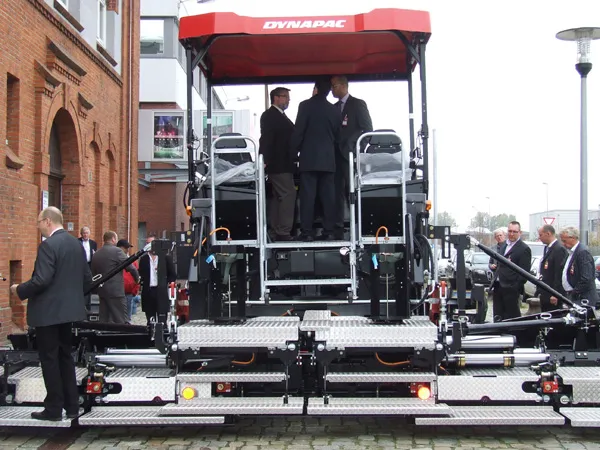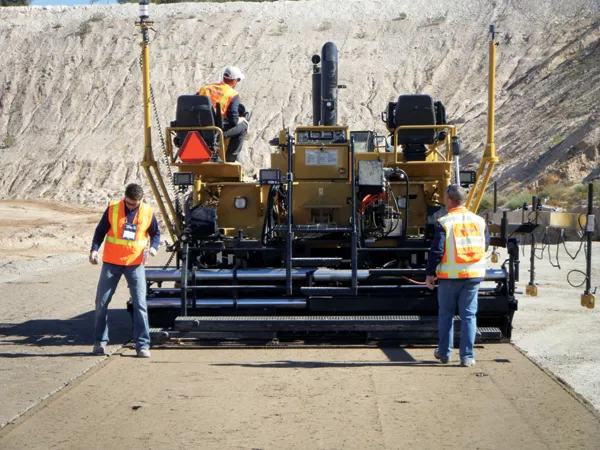A new machine described as an excavator, trencher and crusher is the first of its type operating in the UK and Europe.
Westquay Trading, the exclusive distributors for Tesmec products, has introduced the first 126tonne Rock Hawg, which has been sold to contractor A J Gammond of Malvern, England, pioneers of the use of the machines in the UK and Ireland.
February 28, 2012
Read time: 4 mins

A new machine described as an excavator, trencher and crusher is the first of its type operating in the UK and Europe.
1655 Westquay Trading, the exclusive distributors for 2342 Tesmec products, has introduced the first 126tonne Rock Hawg, which has been sold to contractor 3323 A J Gammond of Malvern, England, pioneers of the use of the machines in the UK and Ireland.
The Rock Hawg TRS1475 is said to provide a powerful excavator, trencher and crusher complete in a single machine, and is capable of removing 300tonnes of material an hour.
Tesmec's products, which are already established in large-scale civil engineering, include chain saws, trenchers and bucket wheels, and while Rock Hawg is a relatively new technology for the demolition, reclamation, civil engineering and utilities industries, in quarries it is said to be a viable alternative to blasting in solid rock areas, preventing rock fragmentation and ground disturbance, critical for quarry areas.
The complete machine for primary rock excavation consists of a large main tractor unit with the Rock Hawg, a toothed drum attachment to the rear of the machine. Built with a trench width capacity of up to 3.81m it can trench working areas in a series of passes. Maximum trench depth is 600mm and the drum can perform at speeds of 21, 30 or 39rpm.
According to Westquay, the potential of the machines was seen at3180 Lafarge's Whitwell Quarry in County Nottinghamshire, England, where a 50tonne Rock Hawg TRS1150 with a trenching width of 2.55-2.9m and trenching depth of up to 600mm, helped construct a haul road. The new Tesmec model was also put through its paces at the quarry.
Gammond secured the contract to rip out rock for the new road, which was part of a huge project which included closing a main highway passing through the quarry and building a new bridge to allow the haul road to proceed underneath.
The project will allow a new area of the quarry to be opened on the opposite side of the existing quarry without having to use the main highway. The Rock Hawg's task was to rip out the rock either side of the newly-installed bridge.
Due to the proximity of the bridge it was impossible to blast this material out, and the Rock Hawg ripped out more than 500m³ of material in two weeks, with the extracted material being useable for sale. This helped self-fund the extraction of the material, which did not require primary crushing.
Shane Tompkin, quarry manager at Whitwell, which produces limestone products, said the new Rock Hawg has potential for quarrying purposes, offering an alternative to blasting, which is a specialised process at the quarry.
He said: "Gammond came in and said it would take two weeks to do the haul road job and out came the rock and we got a first class job. I am excited to see how the new model works."
Bruce Gammond, sales director of A J Gammond, said: "We are trying to prove that we can produce a good material that can be used, and also cut out the need for a primary crusher. It opens up a lot of areas in a quarry where they can't drill and blast."
His 21-year-old son Tom also operates the company's Rock Hawgs, and in another project carried out by Gammond, one was used to level the side of a mountain in Crieff, Scotland, for GMJV so chlorination tanks could be installed for Scottish Water. Blasting could not be used because of the proximity of a village and local businesses. It was felt that hammers and peckers would have been too time-consuming due to the hard and compact stratification of the rock.
Gary Adey of Westquay, based in Warrington, north-west England, said: "There are new ways of doing things and this equipment is one of them."
The Rock Hawg TRS1475 is said to provide a powerful excavator, trencher and crusher complete in a single machine, and is capable of removing 300tonnes of material an hour.
Tesmec's products, which are already established in large-scale civil engineering, include chain saws, trenchers and bucket wheels, and while Rock Hawg is a relatively new technology for the demolition, reclamation, civil engineering and utilities industries, in quarries it is said to be a viable alternative to blasting in solid rock areas, preventing rock fragmentation and ground disturbance, critical for quarry areas.
The complete machine for primary rock excavation consists of a large main tractor unit with the Rock Hawg, a toothed drum attachment to the rear of the machine. Built with a trench width capacity of up to 3.81m it can trench working areas in a series of passes. Maximum trench depth is 600mm and the drum can perform at speeds of 21, 30 or 39rpm.
According to Westquay, the potential of the machines was seen at
Gammond secured the contract to rip out rock for the new road, which was part of a huge project which included closing a main highway passing through the quarry and building a new bridge to allow the haul road to proceed underneath.
The project will allow a new area of the quarry to be opened on the opposite side of the existing quarry without having to use the main highway. The Rock Hawg's task was to rip out the rock either side of the newly-installed bridge.
Due to the proximity of the bridge it was impossible to blast this material out, and the Rock Hawg ripped out more than 500m³ of material in two weeks, with the extracted material being useable for sale. This helped self-fund the extraction of the material, which did not require primary crushing.
Shane Tompkin, quarry manager at Whitwell, which produces limestone products, said the new Rock Hawg has potential for quarrying purposes, offering an alternative to blasting, which is a specialised process at the quarry.
He said: "Gammond came in and said it would take two weeks to do the haul road job and out came the rock and we got a first class job. I am excited to see how the new model works."
Bruce Gammond, sales director of A J Gammond, said: "We are trying to prove that we can produce a good material that can be used, and also cut out the need for a primary crusher. It opens up a lot of areas in a quarry where they can't drill and blast."
His 21-year-old son Tom also operates the company's Rock Hawgs, and in another project carried out by Gammond, one was used to level the side of a mountain in Crieff, Scotland, for GMJV so chlorination tanks could be installed for Scottish Water. Blasting could not be used because of the proximity of a village and local businesses. It was felt that hammers and peckers would have been too time-consuming due to the hard and compact stratification of the rock.
Gary Adey of Westquay, based in Warrington, north-west England, said: "There are new ways of doing things and this equipment is one of them."









